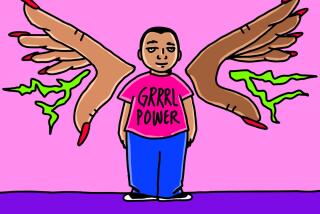Don’t forget the female cartoonists
- Share via
Acknowledging the “subjective” in Geoff Boucher’s “highly subjective guide to some of the best graphic novels” does not erase my concern that Boucher’s article [“Serious About Comics,” Nov. 17], and the exhibition that inspired his article, treat women cartoonists as a side note. In the late 1980s, I began to notice that most newspapers, including The Times, published only two comics by women -- the same two comics, out of a total of 36, that appear in today’s Times: Lynn Johnston’s “For Better or For Worse” and Cathy Guisewite’s “Cathy.” I wondered why that was. The result was the 1991 award-winning film, “Funny Ladies: A Portrait of Women Cartoonists.”
The Hammer Museum and MOCA last weekend launched “Masters of American Comics.” Many who view the exhibition or open The Times’ Comics Plus section will erroneously believe women aren’t cartoonists. Making “Funny Ladies,” I learned the opposite was true. “Funny Ladies” features four of America’s most popular women cartoonists: Dale Messick, creator of “Brenda Starr” (one of the earliest syndicated cartoon strips by a woman), who changed her name from “Dalia” to the sexually ambiguous “Dale” in the late ‘30s to get editors to consider her artwork; Cathy Guisewite, who originated the popular contemporary strip “Cathy”; Nicole Hollander, whose “Sylvia” is the only daily strip in self-syndication; and artist-writer-cartoonist Lynda Barry, the creator of the weekly “Ernie Pook’s Comeek.” The film opens with a visual journey through the history of comic strips created by women between 1900 and 1940. The women include Edwina Dumm, who started her career as America’s first female editorial cartoonist at a time when women did not even have the right to vote; Hilda Terry, who was the first woman to be admitted to the National Cartoonists Society; and Jackie Ormes, an African American cartoonist whose comic-strip heroine confronted social ills ranging from racial prejudice to environmental pollution.
PAMELA BEERE BRIGGS
Westchester
*
As comics are lifted up from under the mattress into the museum, one keeps reading that graphic novels are a new form of communication invented by esteemed comic artist, Will Eisner, whose “A Contract With God” is viewed by many as “the blueprint for the graphic novel.”
Sorry, but the true precedent is elsewhere. In 1945, among the Fourth Avenue used bookstores in New York City, I bought three thick, hardbound volumes printed on laid paper with no words evident except a title and “a novel in woodcuts by Lynd Ward.” They were jumbled in the sidewalk boxes exposed to street dust and people’s coughing. I couldn’t understand why something so rare and fine would be treated so carelessly until the sales clerk told me, dismissively, “Oh, those are just those graphic novels that used to be sold for a quarter in the drugstores during the Depression.”
I thought of the enormous amount of work to produce such volumes, each composed of more than 100 woodcuts. Handsome work, the black and ivory contrast of ink/paper melded with the artist’s angular, somewhat German Expressionist quality of design.
I asked a sophisticated New Yorker friend about these surprising books and the immense amount of work required to make them.
He said cynically, “They weren’t really woodcuts. Those were made with that new plaster-coated stuff that came out in the Depression.” He meant “scratchboard,” which is now sold in kits like “Paint by Numbers” in every art store.
I wish Eisner were here to throw a bouquet to someone who might well have been a mentor.
JEANNE S. MORGAN
Santa Barbara
*
Geoff Boucher left out an important bit of information. Graphic novels are also available (for free!) at most public libraries, which carry many of the authors cited in the article.
CINDY MEDIAVILLA
Culver City
More to Read
The biggest entertainment stories
Get our big stories about Hollywood, film, television, music, arts, culture and more right in your inbox as soon as they publish.
You may occasionally receive promotional content from the Los Angeles Times.










